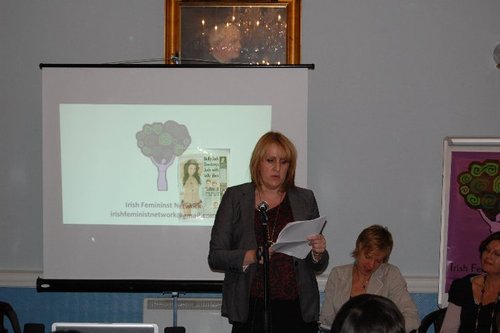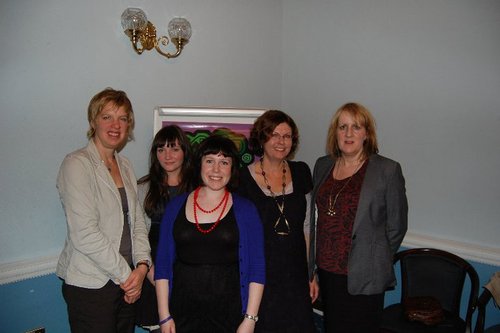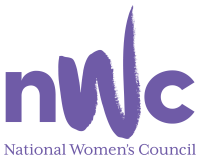Women in the media speech for Irish Feminist Network launch by Anthea McTeirnan
Published: Tuesday, October 05, 2010
I just thought that before I started I'd tell you about Chloe. She's the same age as many of you and, like you, she has definite political views. Yesterday she waded in to the Cementgate controversy, defending Joe McNamara after he drove his 15-tonne cement mixer into the gates of the Dail. Chloe said her heart went out to the Anglo Avenger - "Poor Joe is the only person to appear in court so far over a disaster that's bankrupted a generation of Irish people. Others crashed the entire economy, he just parked a lorry."
Chloe was making a valid point. And considering the 23-year-old is from Leeds, you've got to hand it to her for keeping on top of Ireland's economic trials and tribulations.
I'm sure you're already getting a mental picture of Chloe because she's the same age as some of you.
By and large she wants the same things - independence, to earn a decent living, to be happy and fulfilled.
Where she might differ from some of you is that she works in the media. Glamorous isn't it?
I'm just going to put Chloe's picture up so you can put a face to a name.
And I'm going to leave it there to see if it's possible that anything I'm about to say retains any credibility whatsoever.
[Pins picture of Chloe on Page 3 of The Sun on Thursday, September 30th 2010 to the wall. - Use your imagination.]
 Twenty four years ago British Labour MP Clare Short stood up in Britain's House of Commons to introduce a 10-minute rule bill that would have led to the banning of Page 3.
Twenty four years ago British Labour MP Clare Short stood up in Britain's House of Commons to introduce a 10-minute rule bill that would have led to the banning of Page 3.
How they laughed, how they vilified her. What a killjoy. What a prude.
The Sun made Short's life a misery. At one stage bringing a bus full of Page 3 girls to the house she shared in Birmingham with her 84-year-old mother, Joan, to attempt to bully her into repentance.
Naked breasts over a nation's cornflakes. As Catherine Tate's nan might say... "What a Fuckin' Liberty!"
But it's not a liberty. We knew that then and we know it more clearly now.
As Short said 10 years after her attempted bill: "My own conclusion about the Page 3 phenomenon, and the subsequent proliferation of pornographic-style images across the media, together with the offensive burden of offers of pornography that have to be cleared daily from our e-mail systems, is that we need to push back this ugly coarsening and degradation of our society. I bow to no one in my respect for John Stuart Mill's On Liberty, but I do not believe that inappropriate sexually provocative imagery, plastered across society, is an example of liberty."
One of the staunchest defenders of The Sun's inalienable right to continue the tradition of tits with everything was, ironically, the newspaper's first woman editor - Rebekah Wade.
In fact Wade was so keen to fit in with the lads in The Sun that on the day she took over, the girl on page 3 was none other than "Rebekah from Wapping". Same quirky spelling and everything. Nice work boys.
Whatever Wade may have thought, it would have been just plain rude to spike it after the boys in the newsroom has gone to all that trouble.
And sure enough, Rebekah from Wapping (no, not that one) developed the whole area, innovating a News in Briefs section - see what she did there - that would further blur that fine line between hard core and hard news.
Here's another lovely example. Feel free to apply your own analysis.....
"Katie (19, from Liverpool, who is wearing a lovely pair of medical-issue panties - and little else) says she understands parents' concerns over the new five-in-one jab. Given the level of mistrust the public has shown over MMR jabs, she is concerned enough to chip in with the following statement: 'Tony Blair has done the right thing by publicly reassuring mums and dads. The experts seem to agree that the five-in-one jab is a positive step, so I think most people will put their faith in the Government.'"
Thanks Katie. And thanks Rebekah.
Since the 1960s, feminists have argued that "it matters who makes it." And in the mass media, "who makes it" continues to be men. And they make it in their own image. Or in the image of us some of them prefer.
And they really aren't that worried what we think, either.
On the fourth Global Media Monitoring Day on November 9th, 2009, observers in 130 countries monitored major media outlets.
They found that only 24% of the people interviewed, heard, seen or read about in mainstream broadcast and print news were female.
Women were also persistently underrepresented as experts and authorities: 81% of experts and 82% of spokespersons who appeared across various global media on that day were men..
On Monday night's Frontline, where they addressed a question that affects (one would have thought), everyone in the State, Pat Kenny asked if we'd lost faith in the Government. On his panel were Pat Rabitte, James Reilly, John Curran and Trevor Sargent. The debate lasted an hour. During that hour, 21 men spoke. One female audience member talked for about 30 seconds. That sure ain't 24 per cent. That sure ain't fair and it sure as hell ain't representative.
So we're not worth asking and we're not worth listening to because we don't have a clue what we're talking about.
Rubbish.
Katie, 19, from Liverpool sure seems to know her stuff on the MMR jab. Ironically the statistics will probably record Katie as part of the 18% of female "experts".
Of course there are some of us around in the media the International Federation of Journalists reported that around the world in 2001, 38 per cent of all working journalists were women and in the US, according to research published this year by the American Society of News Editors, 36 per cent of those working full-time in daily newspapers are women.
There's a gaping hole when it comes to research on women in the media here, but we can assume that we're not far off global norms. Unless Frontline has totally messed up our stats.
This morning I went to The Irish Times's morning news conference bearing the good news of what's in tomorrow's edition of The Ticket. There were 13 men and two women. (Clue: one was the editor).
Thirteen to two. That's a fact. Make of it what you will. But ask yourself if that's what you think the news conference in a major national daily newspaper should look like. 
Thankfully studies show that where women hold positions of power, they can make a difference.
In 2000, women editors and journalists took over the newsroom for a single day at a newspaper in Wichita Falls, Texas.
For the day's top story a choice had to be made between a story about a peeping tom and an item about local women fighting for equal rights. When the women chose the latter story, there was a heated debate. Journalist Laurence Pantin reported that "the women finally won, but only because they held the key positions on that day. All other times, the peeping tom and stories like it would have prevailed."
A study carried out in France by the Association of Women Journalists showed that women journalists select six per cent more stories on women than men journalists. So we do make a difference.
However, men continue to occupy approximately 75 per cent of the positions of power in the mass media. And the prospects become even bleaker for women as they climb the corporate ladder. Film industry figures show that women make up only 17 per cent of the creative talent behind the highest grossing Hollywood pictures - 16 per cent of executive producers, 11 per cent of producers, and 2 per cent of cinematographers. No wonder we end up with Sex & the City 2.
As we continue to struggle for equal representation in the media, research by Prof Martha Lauzen of San Diego State University shows that the biggest difference is made by the women who actually work in the industry.
Behind the scenes, women in the media can have a definite impact on the ways women are portrayed on screen and in print.
According to Lauzen: "When women have more powerful roles in the making of a movie or TV show, we know that we also get more powerful female characters on-screen, women who are more real and more multi-dimensional."
It may take a pair of those proverbial bollocks to stand your corner in a newsroom full of suits where the upper echelons are full of opinionated men, but it is where you can make those small differences that can lead to a bigger difference.
It took me two years of hectoring while working as the lone woman in the Irish Times sports department, but I did wear the Sports Editor down and the Irish Sportswoman of the Year Awards are now in their sixth year. Result.
In the United States, only 9% of sports reporters are women. I don't know what Mary Hannigan looks like as a statistic - but she's one woman making that 9% of difference in The Irish Times. Go Mary.
And like Mary, we have to get in there.
The media can be shouty, unpalatable and full of something that rhymes with bricks, but if we're not in it, we really can't win it.
It's not easy. There are night shifts, noise, prejudice and egos to be overcome. And that's just the women. But without achieving critical mass, we'll remain a mass of critics - passive consumers smarting from the sidelines while the guys continue to have their say.
So do complain. Write those letters, ring the Liveline, Tweet your disapproval. Blog. ....
I wonder what Chloe from Leeds would do?
Maybe we should ask her.
Anthea McTeirnan edits The Ticket in The Irish Times.
She is currently chair of the Irish Family Planning Association. The views expressed here are her own.
